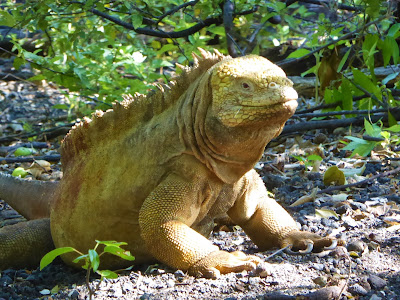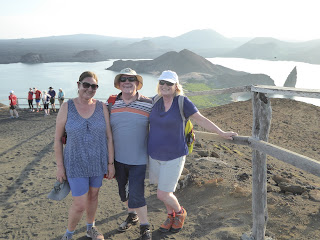Apr 15 – Off to the Galapagos Islands !!
*** Sorry for the gap - no internet at all while at sea for 5 days and even on land now really slow so getting photos on is a challenge. Normal service will be resumed as & when we can !!***
This morning we headed back to Guayaquil airport to
pick up our flight to Baltra Island. This airport was originally a US base
protecting the Panama Canal but now is one of the two airports in the
Galapagos.
 |
| First view of the Galapagos from the air |
 |
| Arriving at Baltra Airport |
Temperature here is in the thirties but very humid,
very like the Easter Island climate. It is still the rainy season here so we
are prepared for some afternoon showers, but not today by the looks of things.
From there a short bus ride and then on to the zodiacs (called Panga’s here) out to the ship. The Athala II is a 16 person catamaran and the cabins and public areas are really nicely done. Certainly more luxurious than our ex Russian survey ship in Antarctica !!
 |
| The Athalla II |
 |
| Our cabin ! |
Once on board we had a briefing from our naturalist
guide who certainly knows his stuff. Similar to Antarctica, it is all about
protecting & conserving the environment, so no food to be taken onto the
islands, Shoes checked for anything in the treads, hose down when you return
etc.
It was also the start of our lessons on the islands
which consist of 244 registered islands with 13 main islands. An island
definition here by UNESCO is any land that sustains any vegetation.
In the late afternoon we took our first trip on to
Mosquera Islet a sandy spit between Baltra and North Seymour. This is home to
one of the largest sea lion colonies on the islands and we had the place to
ourselves. The sea lions were completely unafraid of us and when a couple of
people waded into the water, they played and headbutted them as if they were
part of their colony.
The islet is also home to hundreds of Sally
lightfoot crabs, lava lizards and some marine iguanas.
 |
Sally Lightfoot crabs
|
 |
| Marine Iguana |
 |
| Close up.... |
We mosied around in
amongst them all quite happily even though there were many sea lion cubs still
being weaned. They fed quite happily with us standing just a few feet away.
From there we went back in the panga’s and headed
off to look at the cliffs of Baltra island where the male frigate birds are
trying to attract a female mate by blowing a huge red balloon from their necks.
It takes them about 25 minutes to fully inflate and then once they have
attracted a mate it goes back down. Very photogenic although hard to capture
from a rocking and rolling panga !
Also on parade was the famous Galapagos Blue Footed Booby, can't think where they got that name....
Back to the boat as the sun was setting for
sundowners on deck in the warm balmy evening.
What a great start to our Galapagos adventure……






























































